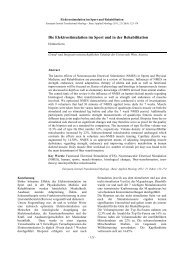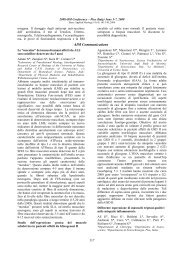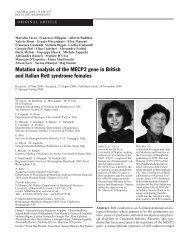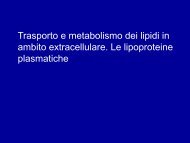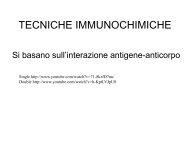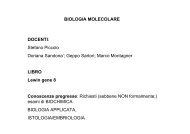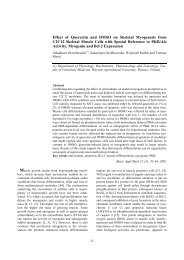Skeletal Muscle Pathology after Spinal Cord Injury: Our 20 Year ...
Skeletal Muscle Pathology after Spinal Cord Injury: Our 20 Year ...
Skeletal Muscle Pathology after Spinal Cord Injury: Our 20 Year ...
Create successful ePaper yourself
Turn your PDF publications into a flip-book with our unique Google optimized e-Paper software.
main cause of muscle atrophy in paraplegics. In the recent<br />
cord lesion, the degree of muscle atrophy was evident<br />
and denervation changes were also seen. In the<br />
later stages of paraplegia the muscle atrophy degree increased<br />
and myopathic changes with focal necrosis and<br />
more extensive fibre degeneration in about 4% of fibres<br />
were observed. The degenerative changes in paralyzed<br />
muscle may be due to the vascular changes reported<br />
below, and the denervation patterns might reflect the<br />
presence of some coincidental alterations of the peripheral<br />
nerve or trans-synaptic degeneration in the<br />
lower motor neuron [13, 28, 38]. In advanced stages<br />
post SCI, muscle atrophy and increase in the interstitial<br />
endomysial connective tissues and perifascicular fatty<br />
infiltration were evident. The significance of the ultrastructural<br />
changes, particularly of the decrease in the<br />
number of muscle mitochondria and of the increase in<br />
cytoplasmic lipid vacuoles, are related to muscle inactivity<br />
and degeneration.<br />
<strong>Muscle</strong> fibre type composition<br />
Normal quadriceps femoris muscle is composed of two<br />
major types of fibre characterized by enzymehistochemical<br />
methods (myofibrillar ATPase pH 9.6 and 4.6): type 1<br />
and type 2 fibres, and numerous sub-types. In our studies<br />
the normal type 1 fibre diameter measures 52.2 µm and<br />
the type 2 fibre diameter 48.2 µm [<strong>20</strong>]. Type 1 fibres are<br />
often of smaller diameter, contain many mitochondria<br />
and do not stain histochemically for myosin ATP-ase activity.<br />
Type 2 fibres are often broad and possess few mitochondria<br />
but they stain intensely for myosin ATP-ase<br />
activity [8]. In Table 1 and 3, morphometric findings on<br />
the fibre diameter and on the fibre type percentage in<br />
rectus femoris, quadriceps femoris, soleus and gastrocnemius<br />
muscle biopsies from paraplegic patients at times<br />
ranging over 1-17 months post SCI are reported. In significantly<br />
early time periods post injury (1-4 months post<br />
SCI) evident preferential atrophy of type 2 fibres was observed,<br />
but no changes in the relative percentage of type 1<br />
and 2 fibres were remarked.<br />
Paraplegia and muscle<br />
Table 3. Mean muscle fibre type diameter in soleus and gastrocnemius muscles of paraplegics (age 16-54) and healthy control<br />
subjects.<br />
Group Soleus muscle Gastrocnemius muscle<br />
(months post SCI)<br />
Fibre type Fibre type<br />
I IIA IIB I IIA IIB<br />
1 (1-2) 30 24 26 28 22 24<br />
2 (3-4) 28 22 24 28 24 24<br />
3 (5-6) 28 24 22 26 24 22<br />
4 (7-8) 26 24 24 24 22 <strong>20</strong><br />
5 (9-10) 16 21 <strong>20</strong> 14 <strong>20</strong> 18<br />
Control 50 48 44 48 46 46<br />
- 78 -<br />
Biopsies performed 4-9 months post SCI showed atrophy<br />
of both fibre types with a reduction in the relative<br />
percentage of type 1 fibres. Following long term SCI<br />
(10-17 months post SCI), upper motor neuron paralysed<br />
muscles lose the normal type 1 and 2 type mosaic pattern<br />
and become predominantly composed of type 2 fibres.<br />
Interesting results have been obtained from the<br />
study of the paretic soleus muscle, that normally is predominantly<br />
composed by slow type 1 fibres. A significant<br />
shift of type 1 fibres to type 2B was observed in the<br />
7-10 months post SCI patient group [<strong>20</strong>, 21, 38, 42].<br />
The above described results support the presence of<br />
progressive changes in paralyzed muscles probably occurring<br />
early <strong>after</strong> cord injury, but most evident 4 months<br />
post SCI. The main interesting change in the contractile<br />
properties of paralyzed muscle <strong>after</strong> SCI is the fibre type<br />
transformation phoenomenon, with type 1 fibre change to<br />
type 2, representing down-regulation of the slow MHC<br />
isoform and upper-regulation of the fast isoform in those<br />
fibres. The shift to type II fibres was more evident in<br />
quadriceps and rectus femoris, and in soleus muscle,<br />
while in the gastrocnemius muscle the fibre type conversion<br />
was less remarkable. Moreover, the plastic modifications<br />
of the fibre types was more evident in young<br />
paraplegics than in older subjects. This result is probably<br />
related to modifications in muscle morphology and in<br />
their contractile properties described in the normal sedentary<br />
aging man [30, 37]. The fast type II predominance<br />
in longstanding paraplegia may explain the problem of<br />
muscle fatigability encountered during rehabilitation exercise<br />
using FES. Studies on experimental spinal cord<br />
transaction showed changes in the rat and cat skeletal<br />
muscle, with almost complete type I to type II fibre transformation<br />
[18, 52]. These changes are different from<br />
those seen in immobilisation in which large increase in<br />
the ratio for fast resistant and slow units are seen [24]. It<br />
may be suggested that in long term paraplegia the loss of<br />
the upper motor neuron control and the spasticity may<br />
induce phoenomena of fibre type transformation. The described<br />
muscular changes in paraplegics are reversible



